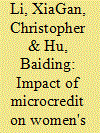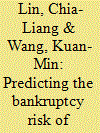|
|
|
Sort Order |
|
|
|
Items / Page
|
|
|
|
|
|
|
| Srl | Item |
| 1 |
ID:
107483


|
|
|
|
|
| Publication |
2011.
|
| Summary/Abstract |
The impact of microcredit on women's empowerment remains controversial, as documented in the microfinance literature. While some studies claim that microcredit helps women increase their income earning abilities, leading to greater power to overcome cultural asymmetries, others contend that small loans allocated to women are usually controlled by their spouses, which results in more severe subordination of women and leaves them more vulnerable to the patriarchy system within the household and/or at society level. This paper evaluates the empowerment impact of microcredit on rural women in China. Logistic regression is employed for empirical analysis and data are collected through a rural household survey. The results confirm that microcredit has a significant impact on five dimensions of women's empowerment, ranging from economic security to awareness of social/legal issues.
|
|
|
|
|
|
|
|
|
|
|
|
|
|
|
|
| 2 |
ID:
107486


|
|
|
|
|
| Publication |
2011.
|
| Summary/Abstract |
Using non-probability purposive sampling, this study matched 23 Taiwanese OTC (Over-the-Counter) bankrupt corporations with 23 non-bankrupt corporations during the period 1999-2005. On the basis of the sample, a predictive and secondary research design was conducted to construct a rolling-prediction model and validate its prediction in Taiwan on OTC corporation bankruptcy risks. The empirical results indicated that the rolling-logit model, compared with the benchmark model, exhibited higher overall accuracy. The successful predictive performances were attributed to a recall mechanism in the rolling-logit model, measuring a corporation's risks on the basis of consistent information across time. However, this study had limitations due to the selection of the sample and variables. These limitations suggest that future research could validate its applicability in other markets or select other explanatory variables in order to improve the predictive ability.
|
|
|
|
|
|
|
|
|
|
|
|
|
|
|
|
| 3 |
ID:
107485


|
|
|
|
|
| Publication |
2011.
|
| Summary/Abstract |
This paper considers economic models of migration in the context of current Chinese migration. We argue that using formally changing one's household registration (hukou) location is too narrow a definition of settlement for policy purposes. Instead we show that time in the city and co-residence with spouses and separately with children reveals systematic settlement behavior on the part of a subset of migrants. The empirical evidence offered is largely descriptive but shows that those migrants who were younger at the age of migration, who are currently married and self-employed spend more years in the city. Men who have been in the city longer and are self-employed are much more likely to be co-residing with their wife. Self-employment is also a predictor of co-residence with children for both mothers and fathers.
|
|
|
|
|
|
|
|
|
|
|
|
|
|
|
|
| 4 |
ID:
107484


|
|
|
|
|
| Publication |
2011.
|
| Summary/Abstract |
This paper investigates the evolution of interprovincial wage inequality and the causes behind its increase over the last two decades. We focus more specifically on the impact of export-led-market reforms on wages disparities within and between five firm types in China. When measured with the GE(1) index, overall wage inequality among Chinese provinces increased by 50% between 1993 and 2007, most notably during the early 1990s as China accelerated its integration into the world economy. The inequality analysis by firm type suggests that increased international competition has had a large impact on wage inequality among domestic firms but almost none on inequality among foreign firms. The panel analysis conducted in this paper also suggests that factors enhancing labor productivity such as larger capital stock endowment per worker and better infrastructure endowment have a greater impact on wage inequality than an increase in economic integration, particularly for domestic firms located in the interior region.
|
|
|
|
|
|
|
|
|
|
|
|
|
|
|
|
| 5 |
ID:
107482


|
|
|
|
|
| Publication |
2011.
|
| Summary/Abstract |
The marginal-products-of-labour (MPL) wage gap is studied in the early-reform Chinese economy, using the Olley-Pakes estimation technique to estimate the production function, based on micro data including different categories of labour. From this measurement of MPL-wage gaps and econometric analyses, several conclusions are drawn. First, the MPL-wage gap was anomalously large for managers in state-owned enterprises (SOEs) compared with other categories of labour. Second, the large MPL-wage gap of managers raised the average MPL-wage gap across various categories of labour, resulting in higher than the average wage MPL throughout the entire workforce, which is regarded as homogeneous. Third, the large MPL-wage gap, or, in other words, the under-employment of managers, occurred not only because the state still centrally employed and allocated labour to SOEs, but because the economy faced a labour-supply constraint of managers in early-reform China. This observation supports a modified version of the state labour-monopsony hypothesis.
|
|
|
|
|
|
|
|
|
|
|
|
|
|
|
|
|
|
|
|
|